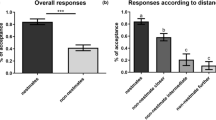Abstract
In queen-right honeybee colonies workers detect and eat the vast majority of worker-laid eggs, a behaviour known as worker policing. However, if a colony becomes permanently queen-less then up to 25% of the worker population develops their ovaries and lay eggs, which are normally reared into a final batch of males. Ovary development in workers is accompanied by changes in the chemical secretion of the Dufour's gland with the production of queen-like esters. We show that ester production increases with the period that the colony is queen-less. The increased ester production also corresponds to an increase in persistence of worker-laid eggs in queen-right colonies, since the esters somehow mask the eggs true identity. However, in a rare queen-less colony phenotype, workers always eat eggs indiscriminately. We found that the egg-laying workers in these colonies were unusual in that they were unable to produce esters. This apparently maladaptive egg eating behaviour is also seen in queen-less colonies prior to the appearance of egg-laying workers, a period when esters are also absent. However, the indiscriminate egg eating behaviour stops with the appearance of ester-producing egg-laying workers. These observations suggest that esters are providing some contextual information, which affects the egg eating behaviour of the workers.

Similar content being viewed by others
References
Châline N, Martin SJ, Ratnieks FLW (2004) Worker policing persists in a hopelessly queenless honey bee colony (Apis mellifera). Insectes Soc 51:113–116
Katzav-Gozansky T, Soroker V, Hefetz A (1997) The biosynthesis of Dufour's gland constituents in queens of the honeybee (Apis mellifera). Invertebr Neurosci 3:239–243
Katzav-Gozansky T, Soroker V, Hefetz A (2002) Evolution of worker sterility in honey bees: egg-laying workers express queen-like secretion in Dufour's gland. Behav Ecol Sociobiol 51:588–589
Katzav-Gozansky T, Soroker V, Francke W, Hefetz A (2003) Honeybee egg-laying workers mimic a queen signal. Insectes Soc 50:20–23
Martin SJ, Jones GR (2004) Conservation of bio-synthetic pheromone pathways in honeybees Apis. Naturwissenschaften 91:232–236
Martin SJ, Jones GR, Châline N, Middleton H, Ratnieks FLW (2002) Reassessing the role of the honeybee (Apis mellifera) Dufour's glands in egg marking. Naturwissenschaften 89:528–532
Martin SJ, Châline N, Jones GR, Oldroyd B, Ratnieks FLW (2004) Egg marking pheromones of anarchistic worker honeybees (Apis mellifera). Behav Ecol 15:839–844
Martin SJ, Châline N, Jones G, Ratnieks FLW (2005) Searching for the egg-marking signal in honeybees. J Negative Results: Ecol Evolut Biol 2:1–10
Miller DG, Ratnieks FLW (2001) The timing of worker reproduction and breakdown of policing behaviour in queenless honey bee (Apis mellifera L) societies. Insectes Soc 48:178–184
Morgan ED (1990) Preparation of small scale samples from insects for chromatography. Anal Chim Acta 261:227–235
Oldroyd BP, Ratnieks FLW (2000) Evolution of worker sterility in honey-bees (Apis mellifera):how anarchistic workers evade policing by laying eggs that have low removal rates. Behav Ecol Sociobiol 47:268–273
Page RE, Erickson EH (1988) Reproduction by worker honey bees (Apis mellifera L.). Behav Ecol Sociobiol 23:117–126
Pickett JA, Williams IH, Martin AP (1982) (Z)-11-eicosen-1-ol, an important new pheromonal component from the sting of the honey bee Apis mellifera (Hymenoptera, Apidae). J Chem Eco 8:163–175
Ratnieks FLW, Visscher PK (1989) Worker policing in honeybees. Nature 342:796–797
Ridley M (1997) The origins of virtue: human instincts and the evolution of cooperation. Viking, New York
Acknowledgements
This study was funded by an NERC standard grant (GR3/12816) and also supported by the European Community's Improving Human Potential Programme under contract HPRN-CT99/00052, INSECTS. The experiments comply with the current laws of the country where the study was carried out
Author information
Authors and Affiliations
Corresponding author
Additional information
Communicated by R.F.A. Moritz
Rights and permissions
About this article
Cite this article
Martin, S.J., Châline, N., Drijfhout, F. et al. Role of esters in egg removal behaviour in honeybee (Apis mellifera) colonies. Behav Ecol Sociobiol 59, 24–29 (2005). https://doi.org/10.1007/s00265-005-0004-0
Received:
Revised:
Accepted:
Published:
Issue Date:
DOI: https://doi.org/10.1007/s00265-005-0004-0




